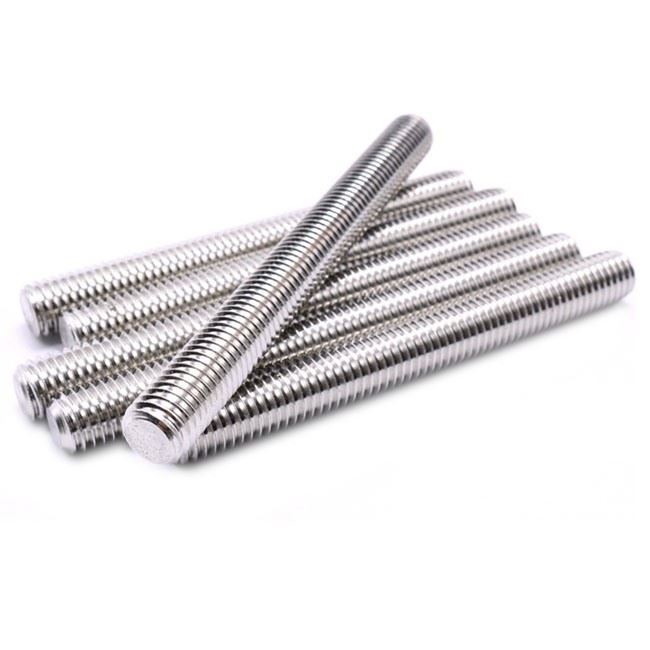Cooperate, use threaded connection to connect two parts into a whole, which is a detachable connection.
Types and uses of bolts:
1. Hexagon bolts (ordinary coarse thread)
Purpose: Cooperate with the nut and use threaded connection to connect the two parts into a whole. It is a detachable connection.
2. Hexagon bolts (normal fine pitch)
Purpose: Like ordinary coarse teeth, use threaded connection to connect two parts into a whole. It is a detachable connection. Fine thread bolts have good self-locking performance, and are used for parts subject to greater impact, vibration or alternating loads, and can also be used for fine-tuning adjustments.
3. Countersunk head bolts
Purpose: The head of the countersunk head bolt can be embedded in the component, and the connection strength is high. It is generally used when the connected parts need to be flat.
4. Eye bolts
Purpose: Eye bolts are used for lifting and hoisting machines and tools for lifting heavy objects. Generally used in equipment that needs to be hoisted, such as motors.
5. U-shaped bolts
Purpose: Generally used for installation and fixation. Generally used in the fixing of pipes and steel wire ropes.
6. Set screws (although they are called screws, they are a kind of bolts)
Purpose: A kind of screw specially used to fix the relative position of the machine parts. There are three types: slot type, inner hexagon type and square head. It is generally used to fix the relative position of the coupling and the key.
7. Studs and studs
One end of the stud bolt can be embedded in the component, and the other end is connected to another part. It is generally used when the connected part cannot or is inconvenient to install the head bolt.
Stud: can be used instead of stud bolts.
Purpose:
Anchor bolts: specifically buried in the concrete foundation, used as the base for fixing various machines and equipment.
Expansion bolt: Generally, it is a special threaded connection in the wall to install machinery equipment or structural parts on the concrete foundation.
Torsion shear bolts: generally used to connect steel components. The head of the torsion shear bolt should be broken after the bolt is tightened.
Swivel bolts: mostly used in occasions or tooling that need to be disconnected frequently.
Flange bolt classification:
1. Hexagonal flange type: There are two types of hexagonal heads, one is flat-brained and the other is concave-brained.
2. Surface color category: According to different needs, the surface has white, army green, color yellow, and dacromet that will never rust.
3. Flange category: According to the different places where flange bolts are used, the size requirements of the discs are different. There are also flat bottom and toothed ones. The toothed ones play an anti-slip effect.
4. According to the force mode of the connection, there are ordinary and reamed holes. The flange bolts used for reaming holes should be matched with the size of the hole and used when subjected to lateral force.
In addition, in order to meet the need of locking after installation, there are rods with holes. These holes can prevent the bolts from loosening when they are subjected to vibration.
Some flange bolts without threaded polished rods need to be thin, called thin rod flange bolts. This flange bolt is conducive to the connection under variable force.
There are special high-strength bolts on the steel structure. The head will be bigger. The size has also changed.
Remarks: GB5789 and GB5787 are commonly used in the market.
Bolt failure factors
Bolt connection is a common connection method. However, in the process of assembling agricultural machinery, due to the influence of various factors or improper assembly, the bolts will have slippage, breakage and other failure phenomena. In the process of bolt on-site assembly, factors such as the angle of bolt tightening and tightening additives are mainly involved.
Influencing factors of bolt failure
The factors to be considered are: the angle of bolt tightening, the use of grease and fasteners, and the tightening method.
(1) Tightening angle
In the on-site assembly of bolts, operators often use wrenches to tighten the bolts. In this process, the center of rotation of the wrench cannot be kept coincident with the center of the bolt, which affects the tightening effect and failure torque of the bolt. Therefore, the bolt The tightening angle is a factor that must be considered.
(2) The use of grease and fasteners is sometimes required to add grease or fasteners to the bolt assembly under different working conditions. Therefore, the use of additives is also one of the factors that must be considered in the bolt failure research test.
(3) Material of gasket
In different assembly positions, gaskets of different materials are sometimes required. Therefore, the material of the gasket is also a factor that should be considered for the failure of the bolt connection.

Link to this article:Introduction To Fixing Bolts
Reprint Statement: If there are no special instructions, all articles on this site are original. Please indicate the source for reprinting:Mold Wiki,Thanks!^^
